Dahlias Profile
Written by Iris
Oct 29 2021
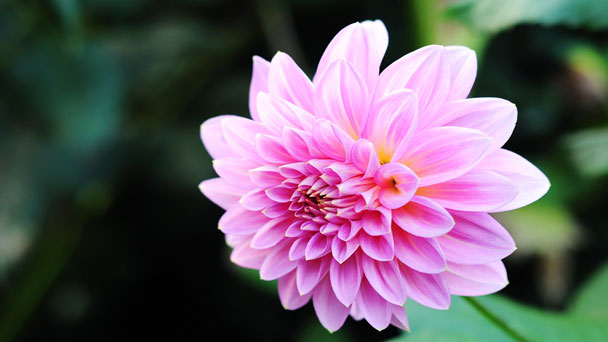
Dahlias grow from tubers. Plant Dahlias tubers in the spring at about the same time as planting the vegetable garden, or when the ground is warm enough to plant and play daily. Plant them in a sunny place and they will bloom throughout the summer. They will bloom, providing you with colorful and rich flowers to cut and enjoy throughout the summer.
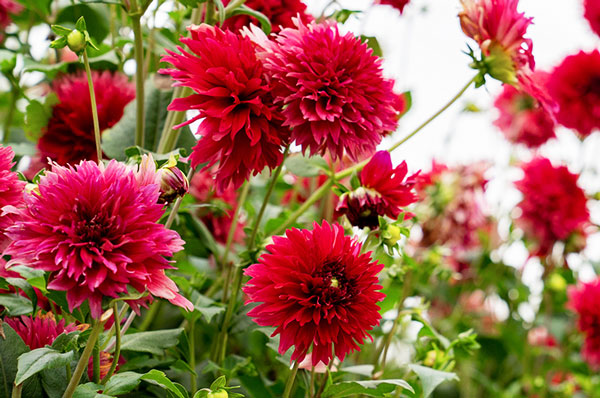
Spanish adventurers took the plant back to Europe by more than 200 years ago. At the Botanical Gardens in Madrid, the Abbe Cavanille named the genus “Dahlia” for Andreas Dahl, a noted Swedish botanist and student of Carl Linnaeus.
Currently, there are 35 species which is being recognized. First species were Dahlia pinnata, D. coccinea and D. rosea. Dahlia being a natural hybrid, developing new varieties from the original simple blooms to a wide range of single and double-flowered blossoms in a saturated bright colors and various shapes which has been easy.
During 1800s, the popularity of Dahlia raised, numerous varieties emerged and were recorded. After the brief amour, the use of dahlia tubers as food crop for supplementation of potatoes, it was decided that it is better suited for decoration than food.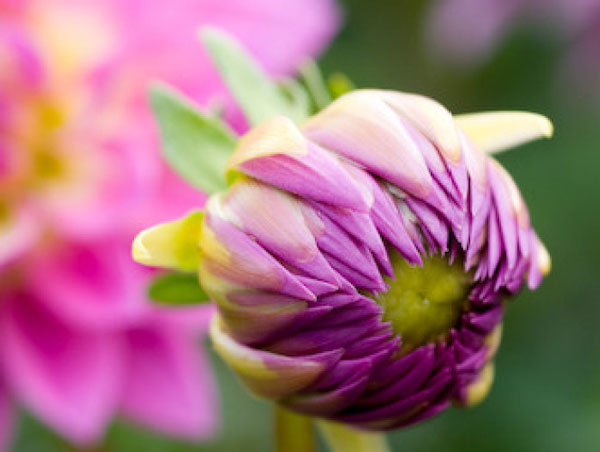
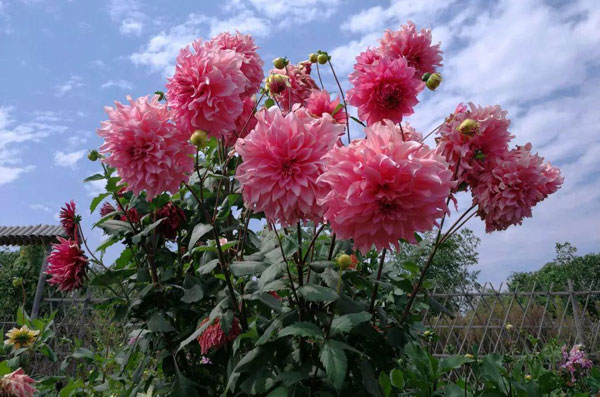
After the cuttings have been dipped in rooting hormone and placed in the rooting medium (either sterile soil or sterile rooting cubes) they should be placed in a humid environment until well rooted. The humidity should be high enough to keep the cuttings from wilting, but not so great as to add moisture to the rooting medium.
Dahlias are photosensitive, and this fact is often overlooked in the process of taking cuttings. Most varieties of dahlias will develop tubers when the day length is 12 hours or less, and will develop feeder roots when the day length is longer than 12 hours.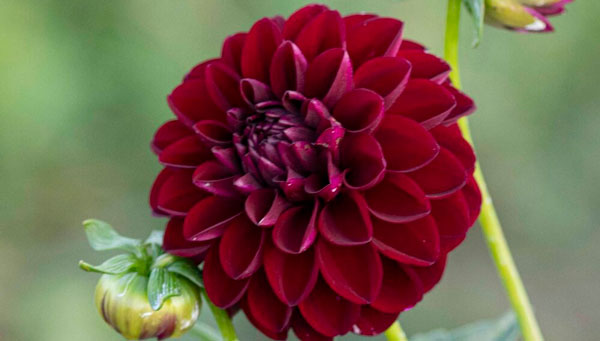
Petals and tubers were used by Aztecs for treating infected grazes, rashes and cracks in skin.
Tubers skin is rich in antibiotic compounds.
The crushed and mashed up petals are used to provide relief from stings or insect bites.
Use poultice made from petals over insect stings and inflamed skin areas.
Use the petals in footsoak to soothe tired feet.
Place the crushed petals on itchy sore spot.
Aztecs use the flowers to treat epilepsy.
‘Bishop of Llandaff’: small, scarlet, intense flowers with handsome, dark-burgundy foliage
‘Miss Rose Fletcher’: an elegant, spiky, pink cactus plant with 6-inch globes of long, quilled, shell-pink petals
‘Bonne Esperance’, aka ‘Good Hope’: a foot-tall dwarf that bears 1-½-inch, rosy-pink flowers all summer that are reminiscent of Victorian bedding dahlias (though it debuted in 1948)
‘Kidd’s Climax’: the ultimate in irrational beauty with 10-inch “dinnerplate” flowers with hundreds of pink petals suffused with gold
‘Jersey’s Beauty’: a 7-foot tall pink plant with hand-size flowers that brings great energy to the fall garden.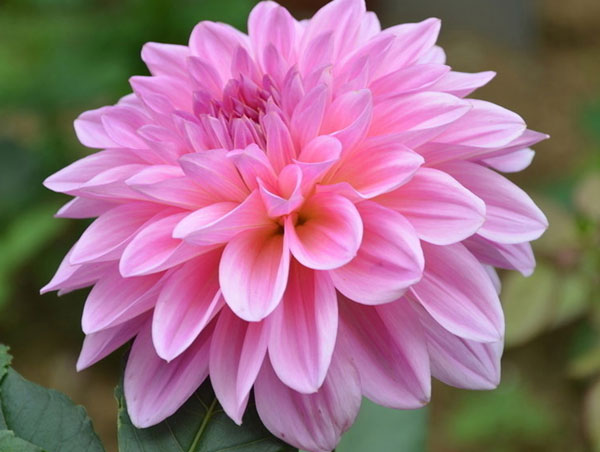
Slugs: Nothing is more disgusting than the sight of a slimy trail on your beautiful leaves or even the ground surrounding your plants, so you might want to keep some slug and snail bait on hand at all times. If you see the slime, you know they are around somewhere and if so, they can destroy your beautiful garden.
Leafhoppers: These plant-feeding pests can destroy the look of your beautiful plant, so if you see signs of them, begin spraying (about every five days) a mix of a pint of insecticidal soap and a tablespoon of isopropyl alcohol.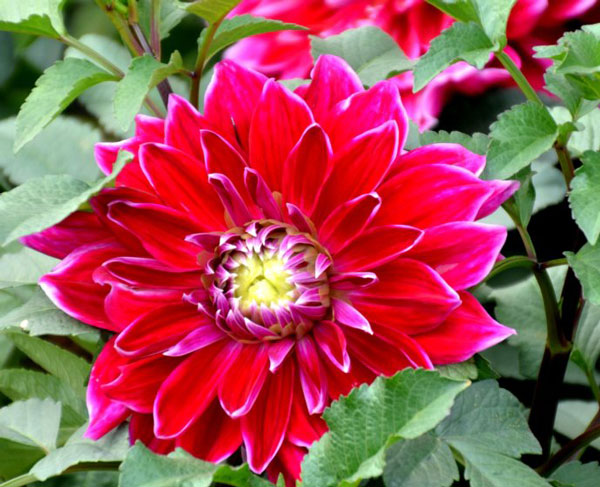
In mild regions and on well-drained soils, you can usually leave the tubers in the ground and cover with a 7.5-15cm (3-6in) deep layer of bark to protect the tubers from frost. In colder areas or on heavy soils, it is far safer to lift and store the tubers for replanting the following spring.
Carefully lift the tubers out of the ground with a garden fork.
Allow them to dry for a few days, so you can clean away any soil clinging to them, preferably upside down in a cool place to allow any moisture in the stems to drain out.
Trim off any fine and damaged roots.
Place the tubers in shallow boxes or trays and pack around them with a peat-free compost or dry sand, just covering the tubers but leaving the crown (where the stems join the tubers) exposed.
Store in a cool, dry, frost-free place over winter.
Inspect the tubers regularly for rotting and discard any that are unhealthy or damaged. (Find more fall flowers here.)
Set one or two stout stakes beside each tuber after you plant them. Wooden stakes can be buried or hammered in. Metal stakes can be placed in the soil more easily and are a great option if you find that your Dahlias need a little extra support after they've grown in.
Have the twine or 'twist-ems' ready to support the stems as they grow. With a little effort, the stakes will be completely hidden by the leaves, but you will thank yourself when your big, beautiful flowers a growing with support.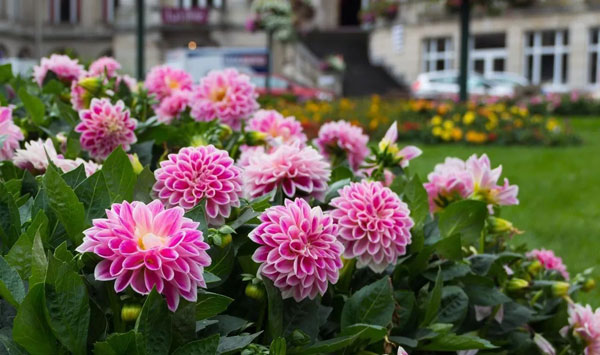
Their lower stems tend to be unattractive and the plants are heavy (especially the large flowered dinnerplate types); so without staking, they tend to flop. Distributing them amongst other plants helps support their weight and also hide their lower stems.
Taller varieties will grow well with perennials and ornamental grasses toward the rear or center of borders, while shorter dahlias mix well with annuals or shorter perennials.
Plant the smallest varieties in containers.
Dahlia flowers are brightly colored, so think about what other flower or foliage colors there are in the landscape, as the dahlias will pick these up and echo them loudly.
Match with other late-flowering perennials, particularly those with similar color, but different texture; such as yellow dahlias and fluffy goldenrods, or purple dahlias and asters.
They can also look surprisingly good with grasses, as the contrast is total—big bright flowers against finely textured grasses.
In more formal settings, their strong colors can be enhanced by the crisp foliage of clipped hedges.
Good cutting dahlias tend to be the larger varieties because of their longer stems.
However they are used, dahlias will be in their full glory by September, and help the summer garden end on a high note.
Read Next:
Top 10 Most Beautiful Roses in the World
Top 10 Most Beautiful Flowers in the World
26 Best Autumn Flowers to Plant for Fall Color in Garden
Top 30 Fall Flowers to Plant Beautiful Autumn Flowers
Dahlias PictureDahlias InfoHistoryDahlias DistributionHow to Grow & Care for DahliasHow to Grow DahliasHow to Care for DahliasUses of DahliasVarieties of DahliasDahlias Common Pests/DiseasesOverwintering DahliasStaking DahliasDahlias Design Tips
Dahlias Picture

Dahlias Info
| Botanical Name | Dahlia |
| Common Name | Dahlia flower |
| Plant Type | Herbaceous perennial |
| Mature Size | 1–6 ft. tall, 1–3 ft. wide |
| Sun Exposure | Full sun |
| Soil Type | Moist but well-drained |
| Soil pH | Neutral to acidic |
| Bloom Time | Late summer, fall |
History
Dahlias are originated in Central America and are inherent from Mexico to Costa Rica. Flowers were known to the Toltecs. In about 1550, an Aztec herbal written in Latin was rediscovered in 1929 and it showed an evidence of the use of Dahlia for treating epilepsy.Spanish adventurers took the plant back to Europe by more than 200 years ago. At the Botanical Gardens in Madrid, the Abbe Cavanille named the genus “Dahlia” for Andreas Dahl, a noted Swedish botanist and student of Carl Linnaeus.
Currently, there are 35 species which is being recognized. First species were Dahlia pinnata, D. coccinea and D. rosea. Dahlia being a natural hybrid, developing new varieties from the original simple blooms to a wide range of single and double-flowered blossoms in a saturated bright colors and various shapes which has been easy.
During 1800s, the popularity of Dahlia raised, numerous varieties emerged and were recorded. After the brief amour, the use of dahlia tubers as food crop for supplementation of potatoes, it was decided that it is better suited for decoration than food.

Dahlias Distribution
Dahlias are native to Mexico where they have been grown for centuries. From there they made their way to Spain via conquistadors who sent seeds of the flower to Madrid along with other seeds of plants and vegetables they had found growing during their explorations. The Dahlia was given its name by botanist and director of the Royal Gardens of Madrid Antonio José Cavanilles, who named the flower after another botanist, Andres Dahl. Dahlias soon spread across Europe and from Mexico to the United States during which time they became an immensely popular garden flower worldwide.
How to Grow & Care for Dahlias
How to Grow Dahlias
Dahlias can be propagated from seeds, tubers, or cuttings.- With Seeds
- With Stem Cuttings
After the cuttings have been dipped in rooting hormone and placed in the rooting medium (either sterile soil or sterile rooting cubes) they should be placed in a humid environment until well rooted. The humidity should be high enough to keep the cuttings from wilting, but not so great as to add moisture to the rooting medium.
Dahlias are photosensitive, and this fact is often overlooked in the process of taking cuttings. Most varieties of dahlias will develop tubers when the day length is 12 hours or less, and will develop feeder roots when the day length is longer than 12 hours.
- With Tubers
How to Care for Dahlias
- Light
- Soil
- Water
- Fertilizer
- Pruning

Uses of Dahlias
In Pre-Spanish Mexico, tubers were used due to high content of fructose and inulin.Petals and tubers were used by Aztecs for treating infected grazes, rashes and cracks in skin.
Tubers skin is rich in antibiotic compounds.
The crushed and mashed up petals are used to provide relief from stings or insect bites.
Use poultice made from petals over insect stings and inflamed skin areas.
Use the petals in footsoak to soothe tired feet.
Place the crushed petals on itchy sore spot.
Aztecs use the flowers to treat epilepsy.
Varieties of Dahlias
There are about 60,000 named varieties and 18 official flower forms including cactus, peony, anemone, stellar, collarette, and waterlily. The American Dahlia Society recognizes 15 different colors and color combinations. Here are some popular choices:‘Bishop of Llandaff’: small, scarlet, intense flowers with handsome, dark-burgundy foliage
‘Miss Rose Fletcher’: an elegant, spiky, pink cactus plant with 6-inch globes of long, quilled, shell-pink petals
‘Bonne Esperance’, aka ‘Good Hope’: a foot-tall dwarf that bears 1-½-inch, rosy-pink flowers all summer that are reminiscent of Victorian bedding dahlias (though it debuted in 1948)
‘Kidd’s Climax’: the ultimate in irrational beauty with 10-inch “dinnerplate” flowers with hundreds of pink petals suffused with gold
‘Jersey’s Beauty’: a 7-foot tall pink plant with hand-size flowers that brings great energy to the fall garden.

Dahlias Common Pests/Diseases
Some of the pests you need to be on the lookout for include aphids, slugs, snails, borers, leafhoppers, and spider mites. If you find any of these, these tips will help you get rid of them.- Aphids
Slugs: Nothing is more disgusting than the sight of a slimy trail on your beautiful leaves or even the ground surrounding your plants, so you might want to keep some slug and snail bait on hand at all times. If you see the slime, you know they are around somewhere and if so, they can destroy your beautiful garden.
- Borers
Leafhoppers: These plant-feeding pests can destroy the look of your beautiful plant, so if you see signs of them, begin spraying (about every five days) a mix of a pint of insecticidal soap and a tablespoon of isopropyl alcohol.
- Spider mites

Overwintering Dahlias
Dahlias are generally not very frost hardy. After the first autumn frosts have blackened the foliage, cut back the stems to around 10-15cm (4-6in) from the ground.In mild regions and on well-drained soils, you can usually leave the tubers in the ground and cover with a 7.5-15cm (3-6in) deep layer of bark to protect the tubers from frost. In colder areas or on heavy soils, it is far safer to lift and store the tubers for replanting the following spring.
Carefully lift the tubers out of the ground with a garden fork.
Allow them to dry for a few days, so you can clean away any soil clinging to them, preferably upside down in a cool place to allow any moisture in the stems to drain out.
Trim off any fine and damaged roots.
Place the tubers in shallow boxes or trays and pack around them with a peat-free compost or dry sand, just covering the tubers but leaving the crown (where the stems join the tubers) exposed.
Store in a cool, dry, frost-free place over winter.
Inspect the tubers regularly for rotting and discard any that are unhealthy or damaged. (Find more fall flowers here.)
Staking Dahlias
If you're growing big dahlia plants, staking will be important. We recommend being pro-active, and setting up your stakes when you plant your Dahlia tubers. The beautiful foliage grows on somewhat brittle stems, and heavy rain, wind, or even the weight of the flowers once they've opened can break the plant. You don't want that to happen, especially at bloom time!Set one or two stout stakes beside each tuber after you plant them. Wooden stakes can be buried or hammered in. Metal stakes can be placed in the soil more easily and are a great option if you find that your Dahlias need a little extra support after they've grown in.
Have the twine or 'twist-ems' ready to support the stems as they grow. With a little effort, the stakes will be completely hidden by the leaves, but you will thank yourself when your big, beautiful flowers a growing with support.

Dahlias Design Tips
There are many ways to use dahlias in the garden. Here are a few tips and suggestions:Their lower stems tend to be unattractive and the plants are heavy (especially the large flowered dinnerplate types); so without staking, they tend to flop. Distributing them amongst other plants helps support their weight and also hide their lower stems.
Taller varieties will grow well with perennials and ornamental grasses toward the rear or center of borders, while shorter dahlias mix well with annuals or shorter perennials.
Plant the smallest varieties in containers.
Dahlia flowers are brightly colored, so think about what other flower or foliage colors there are in the landscape, as the dahlias will pick these up and echo them loudly.
Match with other late-flowering perennials, particularly those with similar color, but different texture; such as yellow dahlias and fluffy goldenrods, or purple dahlias and asters.
They can also look surprisingly good with grasses, as the contrast is total—big bright flowers against finely textured grasses.
In more formal settings, their strong colors can be enhanced by the crisp foliage of clipped hedges.
Good cutting dahlias tend to be the larger varieties because of their longer stems.
However they are used, dahlias will be in their full glory by September, and help the summer garden end on a high note.
Read Next:
Top 10 Most Beautiful Roses in the World
Top 10 Most Beautiful Flowers in the World
26 Best Autumn Flowers to Plant for Fall Color in Garden
Top 30 Fall Flowers to Plant Beautiful Autumn Flowers
Latest Updated
- Benefits of Bugleweed - 7 Science-backed Health Benefits
- Bugleweed Dangers & Side Effects - Is It Poisonous?
- How to Plant Evergreen Trees - What You Should Know
- When to Plant Evergreens - Grow Guide for Evergreen Trees
- 12 Wonderful Evergreen Shrubs for Your Garden
- 12 Popular Evergreen Plants with Pictures for Beginners
- When And How To Prune A Lilac Bush Like a Pro
- How to Grow & Care for Lilac Vine (Hardenbergia Violacea)
- Japanese Lilac Tree (Syringa Reticulata) Care & Propagation Guide
- Shumard Oak Pros and Cons - What to Know
Popular Articles
- Winter maintenance of Antirrhinum Majus
- How to Grow Terminalia Mantaly Tree
- How to Grow and Care for Crossostephium Chinense
- How to grow Antirrhinum Majus in spring
- Peristeria Elata (Dove Orchid) Profile: Info & Care Guide
- Underwatered Snake Plant (Sansevieria Trifasciata) - Signs And How To Fix
- How to Care for Brazilian Jasmine Plant (Mandevilla Sanderi)
- How to Grow & Care for Graptopetalum Purple Delight in Summer
- Rosa Chinensis (China Rose): Plant Growing & Care Tips
- How to Care for Baby Sun Rose (Aptenia Cordifolia)